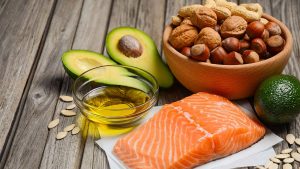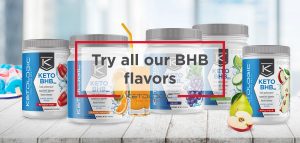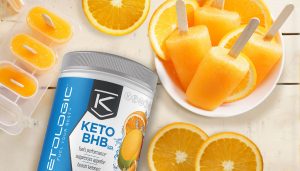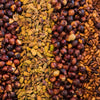Top Keto Acronyms and Glossary

We're here to introduce you to the lingo of the keto world with our list of the top Keto Acronyms you need to know, plus a Keto Glossary that explains the most commonly asked questions. Some questions we answer: How is Keto different from the Atkins Diet and the Paleo Diet? Is ketoacidosis something keto followers need to worry about? What are macros and net carbs, and how do we calculate them?
Keto Acronyms
ACV - Apple Cider VinegarAS - Artificial Sweeteners, such as Splenda® (sucralose), Equal® (aspartame), and Sweet’N Low® (saccharin)
BF – Body Fat
BG – Blood Glucose
BHB - Beta Hydroxybutyrate
BMI – Body Mass Index
BMR - Basal Metabolic Rate
BPC – Bulletproof Coffee
BPT - Bulletproof Tea
CI/CO – Calories In Vs. Calories Out
CO – Coconut Oil
EF - Egg Fast
EVOO - Extra Virgin Olive Oil
FF – Fat Fast
HIIT - High Intensity Interval Training
HWC - Heavy Whipping Cream, a common keto diet ingredient
IF - Intermittent Fasting
IIFYM - If It Fits Your Macros. This describes a type of flexible dieting that helps people lose weight without feeling overly restricted. Instead of counting calories, IIFYM tracks macronutrients (fat, protein, carbs) instead. This allows all foods to be enjoyed as long as they fit within the macros for the day.
IR – Insulin Resistance
KCKO - Keep Calm and Keto On
LBM – Lean Body Mass
LC – Low-Carb
LCHF - Low-Carb/High Fat
MCT - Medium chain triglycerides
NSV - Non-scale victory. An example is when you lose inches but the scale doesn’t move. A common NSV is fitting into a pair of pants that were previously too tight.
SAD – Standard American Diet
SF – Sugar Free
SKD - Standard Ketogenic Diet
T1D – Type 1 Diabetes
T2D – Type 2 Diabetes
WOE - Way of Eating
Keto Glossary
Atkins DietThe Atkins Diet is a low-carb eating plan developed by Dr. Robert C. Atkins. It has four phases for weight loss and maintenance. The first phase drastically cuts carbs, then allows more carbs with each phase. In all four phases, dieters are encouraged to consume the bulk of their calories in protein and fats. The primary difference between Atkins and Keto is that Atkins does not limit protein intake the way Keto does. Because the body can convert many amino acids from protein into glucose, the Atkins diet typically does not produce a state of ketosis in the third and fourth phase due to a combination of higher protein and higher carbs.
Beta Hydroxybutyrate (BHB)
BHB is a naturally occurring metabolite formed from the breakdown of fat, known as a ketone body. It is also a dietary supplement ingredient that is self-affirmed Generally Recognized as Safe (GRAS). BHB raw material is typically supplied as a stable mineral salt, such as BHB sodium, BHB calcium, or BHB magnesium. BHB is an energy-dense molecule that naturally fuels your brain, heart, and muscles during periods of low carbohydrate intake.
SHOP NOW: KetoLogic® BHB
Carb Creep
This describes the process of slowly adding more carbs to your diet until it’s too much. The problem is that “too much” varies by person, so you have to monitor the following to figure out when you’ve reached your personal carb limit.
- Weight: you stop losing weight, or start gaining weight (if you’re trying to maintain)
- Hunger: you start craving food and feeling excess hunger
- Energy: your energy level drops, you feel more lethargic (carbs are weighing you down literally and figuratively!)
- Mood: your mental focus diminishes, your sleep quality declines
- Ketosis: your blood ketones drop below recommended levels
DKA is a buildup of excess blood ketones due to sustained high blood sugar without insulin availability. When bodily fluids become acidic, some of your bodily systems will stop functioning properly, which can have deadly consequences. DKA is very different from ketosis and only occurs in type 1 and type 2 diabetics. Common symptoms are excessive thirst and urination, nausea, and vomiting. It is also important to note that DKA is a state of excess ketones combined with sustained high blood sugars. Healthy individuals who are in ketosis from a ketogenic lifestyle are not at risk for Ketoacidosis or DKA.
Electrolytes
Electrolytes (sodium, magnesium, calcium, and potassium) are critical on the keto diet due to the loss of water when you cut carbs drastically. Electrolytes regulate the flow of water in and out of cells, and spark nerve impulses. In other words, they keep our bodies functioning properly. Electrolyte deficiency can impact your blood pressure, breathing, and other important functions. Replenishing electrolytes is critical to avoiding the side effects (fatigue, grogginess, headaches) typically associated with the keto lifestyle.
Exogenous Ketones
Exo- means “coming from the outside” whereas Endo- means “coming from the inside.” Endogenous ketones (beta hydroxybutyrate, acetoacetate, acetone) are produced from fatty acids inside our body by our liver. Exogenous ketones are ketone bodies (typically in the form of salts) that we eat or drink rather than produce. They provide the same level of energy and can help train our cells to become more proficient at utilizing ketones, both exogenous and endogenous. An example of an exogenous ketone supplement, as well as a good source of electrolytes, is KetoLogic® BHB.
TRY OUR RECIPES: Ketone Cocktail, Ketone Popsicles, Ketone Slushies
Fat-Adapted
Fat-adapted (also referred to as keto-adapted) describes your body’s metabolic response after fully transitioning to the ketogenic lifestyle. It takes time for your body to become proficient at digesting fats and subsequent ketone production and usage for optimum performance and health. For most people, this is somewhere between 1-3 months of following a ketogenic lifestyle. Once fat-adapted, some people find that they have a higher carb tolerance, meaning they can increase their daily intake of net carbs and still remain in ketosis. Being fat-adapted helps make the ketogenic lifestyle more sustainable in the long-term.
Fat Bombs
This term describes food that provides a lot of fat with minimal protein and carbs. If you’re on a ketogenic diet, ensuring that your diet contains enough healthy fats can be tricky, especially if you’re new to this way of eating. Common fat sources such as meat and cheese typically also come with protein. But since protein should only make up 20% of your diet, fat bombs are often needed to reach your daily fat macros. That’s where fat bombs come in: high in fat and low in protein and carbohydrates, they’re the ideal snack if you’re eating keto. Examples include macadamia nut butters, avocados, and heavy cream.
SHOP NOW: FBOMB Macadamia Nut Butters
Fatty Acids
Fatty acids are the building blocks of the fat in our bodies and in the food we eat.
- Monounsaturated Fatty Acids (MUFA): Monounsaturated fatty acids (omega-9, oleic acid) are found in avocados, olives, beef, and nuts (especially macadamias) and have been shown to prevent heart disease. Since they are less stable than SFA, oils high in MUFA (extra virgin olive oil, avocado oil, and macadamia nut oil) are best used for finishing meals after cooking to add flavor and heart-healthy fat.
- Polyunsaturated Fatty Acids (PUFA): Polyunsaturated fats -- Omega-3 and Omega-6 fatty acids -- are both essential to our bodies. However, our diet is often overloaded with PUFA due to processed foods, which are higher in Omega-6. Too much omega-6 can cause inflammation. Most commercial vegetable oils, including canola, corn, soybean, and grapeseed oils, are high in PUFA and should be avoided. Because it's likely you are already getting enough (or too much) omega-6 fatty acids, focus on increasing your intake of omega-3 foods, such as wild salmon, grass-fed meat, walnuts and macadamia nuts. Grass-fed meat is a good source of omega-3 fatty acids, while grain-fed meat is loaded with omega-6 fatty acids. In addition to consuming good sources of omega-3 and omega-6 fatty acids, it’s also important to consume them in the proper ratio. That’s because excessive intake of Omega-6 can inhibit the benefits of Omega-3. The ideal ratio of Omega-6 to Omega-3 is between 1:1 and 4:1. Most people eating a Standard American Diet eat a ratio between 10:1 and 25:1.
- Saturated Fatty Acids (SFA): Saturated fats are found in animal sources, including meats, eggs, and dairy, as well as tropical oils such as coconut oil and palm oil. In addition to being the most stable, they have long shelf lives and high smoke points. Most of your fat intake should come from saturated and monounsaturated fats.

Gluconeogenesis
Gluconeogenesis is the natural and essential body process of creating glucose from other substrates such as amino acids (from protein) and glycerol (from fat) in the absence of dietary or stored glucose. Glucose is an essential fuel for a small number of cells and body functions, so this is a normal daily process for many individuals on a ketogenic diet. However, if protein intake regularly exceeds fat intake, gluconeogenesis will be greater and can cause elevations in blood glucose, which may prevent ketosis.
Insulin Resistance (IR)
Insulin resistance (IR) is a physiological condition in which cells fail to respond to the normal actions of the hormone insulin. When the body produces insulin under conditions of IR, the cells in the body are resistant to the insulin and are unable to use it as effectively, leading to sustained high blood sugar. Beta cells in the pancreas subsequently increase their production of insulin, further contributing to a high blood insulin level and increased inflammation which can lead to cardiovascular disease. This often remains undetected and can contribute to a diagnosis of Type 2 diabetes or latent autoimmune diabetes of adults.
Intermittent Fasting (IF)
Intermittent fasting describes an eating pattern where you cycle between periods of eating and fasting. It focuses on when to eat, not what to eat. Various methods of IF exist, with the 16/8 method being the most popular. No food is allowed during fasting periods. Non-caloric beverages are permitted, such as water, coffee, and tea.
READ: The most popular methods of Intermittent Fasting

Keto/Ketogenic Diet
The ketogenic (“keto” for short) diet was initially developed as a therapeutic way to treat seizures in patients with epilepsy. The keto diet is made up of 75% fat, 20% protein, and 5% carbohydrates. This combination enables your body to enter a state of ketosis, where the body switches from burning carbs for fuel, to burning fat for fuel. The Standard Ketogenic Diet (SKD) limits carbs to 20-50 grams per day.
READ: The Pros and Cons of a Low-Carb/High-Fat Way of Eating

Keto Flu
The Keto Flu describes a flu-like feeling that hits some people in the beginning of starting the keto diet. This can happen for two reasons: (1) As your body switches from carb-burning to fat-burning mode, your brain may run low on energy, leading to nausea, headaches, and grogginess. (2) You’re dehydrated and low on electrolytes because depletion of glycogen stores from eating a ketogenic diet causes you to urinate more frequently. This leads to a depletion of essential electrolytes, including sodium, magnesium and potassium. Drinking extra water and replenishing your electrolytes can prevent the Keto Flu or minimize symptoms.
READ: The Top 10 Things You Need to Know Before Going Keto
Ketoacidosis
Ketosis is sometimes confused with ketoacidosis, which is a potentially dangerous condition. Ketoacidosis is rare and can be caused by uncontrolled diabetes, drug or alcohol abuse, and severe illness or infection causing a rise in cortisol and adrenaline which counter the effect of insulin. The level of ketones in ketoacidosis are 3-5 times higher than in dietary ketosis resulting from a ketogenic diet. Healthy individuals who are in ketosis from a ketogenic lifestyle are not at risk for Ketoacidosis.
Ketones
Ketones usually refers to ketone bodies (beta hydroxybutyrate, acetoacetate, acetone) which are produced by the liver by the breakdown of fatty acids. They are then used by your cells and brain for energy in the absence of glucose from carbohydrates.
READ: Why Taking BHB on the Keto Diet can be Beneficial
Ketosis
Ketosis is a natural metabolic state in which your body breaks down fat to produce energy, rather than relying on glucose from carbohydrates. Ketosis simply means you have ketone bodies circulating in your blood at levels above 0.4 mmol/liter. Fat is broken down into fatty acids and glycerol, which can be used by many cells for energy, but these substances must be converted into ketones in the liver to be used as energy by the brain.
READ: How to Determine if You're in Ketosis

Macros
Macros are short for macronutrients, which are protein, fat, and carbohydrates. The recommended macro breakdown for keto is 75% fat / 20% protein / 5% carbs. A gram of fat is 9 calories, a gram of protein is 4 calories, and a gram of carbohydrate is 4 calories. Based on a 2,000 calorie diet, a 75/20/5 macro breakdown means you would consume 167g fat, 100g protein, and 25g carbohydrates.
On a related note, micronutrients refer to vitamins and minerals, which are also essential for body functions, but in smaller quantities.
Medium Chain Triglycerides (MCT) Medium chain triglycerides (MCT) are saturated fats that are easily digestible by our bodies. They are absorbed from the intestine directly into the bloodstream and passed to the liver to be used as an immediate form of energy. MCTs are also most efficiently converted into ketone bodies, making it a more ketogenic fat source compared to long chain triglycerides. MCTs are mostly found in coconut oil, but also present in butter and palm oil.
READ: MCT Powder vs. MCT Oil - Which One's Better for Your Health?

SHOP: Try all 3 KetoLogic® KetoMeal® shakes!
Metabolic Syndrome
Overconsumption of carbs may be one of the causative factors in the development of metabolic syndrome. Metabolic syndrome is a cluster of co-occurring symptoms, including increased blood pressure, high blood sugar, excess body fat around the waist, and abnormal cholesterol or triglyceride levels.
Net Carbs
To calculate Net Carbs, you subtract fiber and sugar alcohols from total carbs. The formula is Total Carbs – Fiber – Sugar Alcohols = Net Carbs. Most keto followers stay between 20-50 grams of net carbs per day. Net carbs are the ones that your body can use for fuel and thus can convert to glucose. Fiber and sugar alcohols are not digestible so therefore have no impact on blood sugar levels.
Paleo Diet / Primal Diet
Both diets are based off of evolutionary science and believe our ancestors’ diet 100,000 years ago is healthier than the Standard American Diet. They focus on eating natural foods that made up the bulk of our ancestors’ diet prior to the existence of processed carbs. Paleo- and Primal-friendly foods include fruits, nuts, vegetables, and grass-fed meats. Foods introduced after the agricultural revolution are prohibited.
Key differences between the Paleo and Primal diets:
- Paleo prohibits dairy; Primal considers dairy to be a healthy source of fat and protein
- Paleo restricts nightshade vegetables (eggplant, tomatoes, peppers, potatoes); Primal allows potatoes
- Paleo opts for leaner meats; Primal opts for fattier meats
Conclusion
We hope this Keto crash course is helpful to you on your keto journey. We'll update this as we learn more!*********************************
Want to jumpstart your weight loss? Take our KETO 30 Challenge!

-
Posted in
Authority Article, Nutrition, Starting Keto








